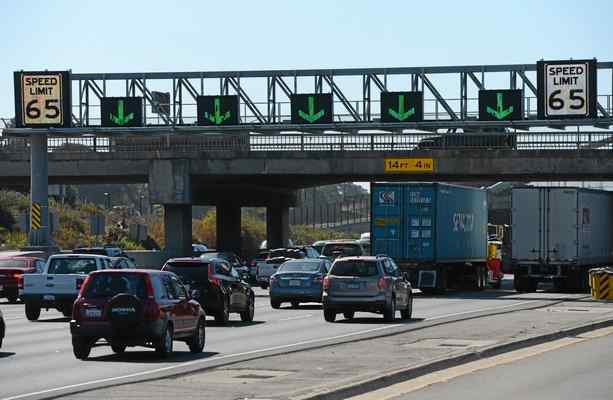
Signs for the Interstate 80 "smart highway" project were demonstrated in Berkeley in September. The $79 million project includes advanced traffic monitoring systems. (Kristopher Skinner/Bay Area News Group)
Caltrans set to unveil ‘smart highway’ for East Bay congestion
http://www.marinij.com/article/NO/20160710/NEWS/160719986

Signs for the Interstate 80 "smart highway" project were demonstrated
in Berkeley in September. The $79 million project includes advanced traffic
monitoring systems. (Kristopher Skinner/Bay Area News Group)
By Gary Richards, Bay Area News Group
Posted: 07/10/16
1
Comment
In hopes of easing the Bay Area’s most jammed freeway, Caltrans will begin unveiling its Interstate 80 “smart highway” project within a few days, phasing in 20 miles’ worth of electronic improvements from the Carquinez Bridge to the Bay Bridge.
The $79 million SMART Corridor project is the most intensive one in the state, with advanced metering lights and lane-closure warnings and even variable speed-limit signs that can be lowered to 55 mph, or 30 mph, or whatever conditions warrant.
All of these real-time traffic-monitoring tools are located on the westbound side of the notorious freeway that carries 270,000 vehicles each weekday. The primary goal is to reduce the accident rate on this stretch; it’s twice as high as the statewide average for comparable highways such as Interstate 405 in Southern California. Caltrans engineers also hope to adjust and smooth the flow of traffic.
“Interstate 80 has horrid traffic seven days a week, and usually the jam on weekdays extends well past 7 p.m.” said Oakland commuter Gary Lindsay.
Within days motorists will see large traffic information boards light up from Vallejo through Contra Costa and Alameda counties and onto the Bay Bridge approach in Berkeley-Emeryville.
By Labor Day, metering lights at 44 ramps will be in full operation. Also, traffic signals will be adjusted on San Pablo Avenue to help motorists when they use that parallel thoroughfare as a detour; signs will activate on San Pablo when an incident has cleared and it’s safe to return to the freeway.
“There are many other components,” Caltrans spokeswoman Ivy Morrison said. “The traffic boards are highly visible, though, and therefore a great way to notify motorists about the project.”
The price tag, while hefty, is many millions less than making the freeway 10 or 12 lanes.
“Widening I-80 would cost hundreds of millions and would take a lifetime to build,” said Ross Chittenden, deputy executive director of the Contra Costa County Transportation Authority. “Employing technology costs a fraction of this amount and can provide relief as soon as the system is turned on.”
The ramp meters will manage the flow of vehicles onto Interstate 80 in real time, with traffic monitors in Caltrans’ operation center in Oakland changing the messages on all those new signs almost instantly, making it safer for drivers to merge onto I-80 and alleviating backups on local streets.
These upgrades are needed, transportation officials say, because traffic data
show that a significant number of collisions on this stretch are rear-enders,
or “secondary” accidents unrelated to a primary accident up ahead.
They hope to see the sort of success found in the Seattle area, where a recent evaluation of SMART Corridor-type elements there showed a decrease in collisions of as much as 25 percent.
Highway 101 along the Peninsula is the only other Bay Area freeway with similar “smart” elements. There, dozens of electronic signs on El Camino Real from San Bruno to East Palo Alto alert drivers about how to return to the freeway when there is a problem on 101.
This is in response to a big-rig crash several years ago that closed 101 for a few days, and had motorists scurrying to find a way through Peninsula cities. The $35 million project was the first “smart highway” effort in the Bay Area.